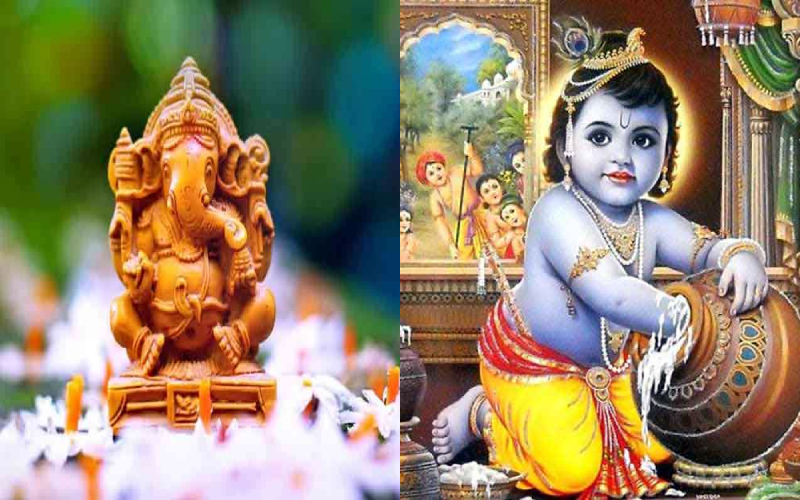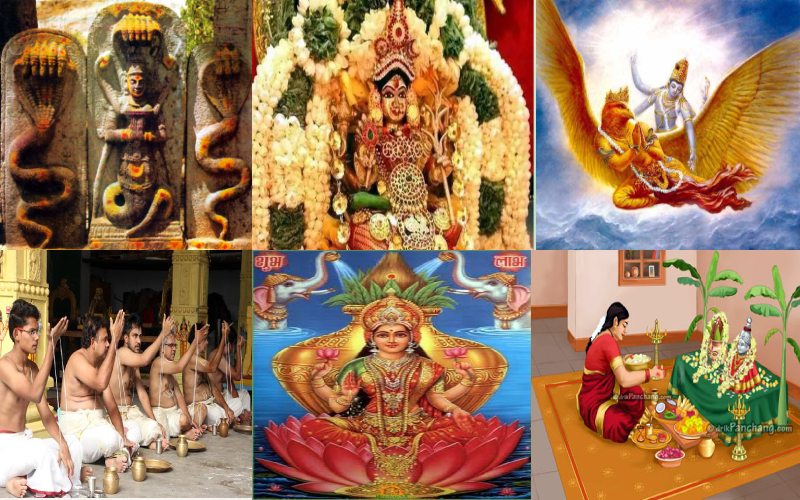
The Tamil month, ‘Aadi,’ is known as ‘Aashadam’ in Telugu. It is the time to celebrate thanksgiving through the observance of Vratas. The devoted begin with ‘Naaga Chaturthi,’ ‘Garuda Panchami,’ ‘Varalakshmi Vratam,’ ‘Shravanaalu’ (Sacred thread changing ceremony), ‘Polala Gowri Vratam,’ ‘Gowri Vratam,’ ‘Ganesh Chaturthi,’ and ‘Sri Krishna Jayanthi.’ All these festivals occur over a period of two months and hence require planning and preparation.
Traditional homemakers would prepare themselves a week before the first festival, i.e., 'Naaga Chaturthi'. They will clean up the entire Pooja room/shelf in an elaborate manner. Dusting, removal of cobwebs, and cleaning up of every portrait, icons, lamps, and utensils would be done. They would clear of all the leftover consumables in one go. Thereafter, they would replace them with Agarbatti, Camphor, Turmeric, Sandalwood powder, Kumkum, Turmeric pods, broken Areca nuts, Oil, Ghee, Wicks for lamps, Perfumed-water, Sacred threads, Yellow Mangalsutra thread, Cotton slivers, Turmeric coated rice (Akshatha), Vibhuti (Holy ash), Go mutra (Indian Cow’s urine), Namam sticks, Gangajala, etc.
The stocks in the storeroom would be looked into and the grocery list will be prepared. Some of the items would be exclusive for the Poojas and therefore would be made note of. Thereafter, an indent would be placed with the grocer for the Pooja room consumables and groceries as well. The Naivedyam (Prasadam) ingredients will be bought afresh, and normally existing items found in the store will not be used.
The ladies of the house will inform the flower vendor, and the Kolapodi supplier, the dates when the things need to be supplied. The vegetable vendor, fruit seller would be forewarned so that the requisite items are kept ready. Items like Betel nut leaves, Plantain leaves, and Mango leaves would be sourced on the earlier day to the festival. Wearing Conjeevarams was meant to be sacred and pure. Therefore, the ladies at home would pull out the right ones and keep them ready. Festivals are moments when lots of vessels would be used and they will be kept ready too. The women of the house would like to wear some extra jewelry for they would be visiting other homes and would get visitors too. Hence, the women would get the jewels ready in order to use them.

Big joint families would require a lot of Naivedyam to be made and therefore they would appoint a contract festival cook for the season. The family priest will be engaged in performing the rituals and offerings made for God would be set aside. Gifts for visitors will be acquired from numerous sources and kept ready. The family members and particularly women would not travel during the festival season. Some family heads (Usually the eldest lady in the house) were known to make an offering for the Kuladevata in order to ensure a smooth passage of the festivals. The complete residence would be cleaned and spruced up in anticipation of the festivals. The Homakund will be kept ready for the purpose of conducting fire worship at the time of Shravanaalu.
The house budget would include a provision for the celebration of festivals too. A menu would be set for the Naivedyam and also the list of regular food to be had on the festive days. It was a practice to add some novel item in terms of infrastructure every year. The burgeoning size of the family necessitated all these. The family priest would normally give a festival chart at the beginning of the year, and this would serve as the reference point. These festivals were therefore planned properly, and the homemaker functioned like an Operations Research expert who could draw a critical path in no time. The SOPs (Standard Operating Procedures) varied from families to families and were normally documented in the interest of the next generation.
Thus, art, craft, prayer, devotion, rituals, and beliefs became the various tiny rivulets which flowed out of the mountain range called ‘Custom & Tradition.’ These collective rivulets, combined with celebrations, purified the body and soul of every family member. This combination of all can be called the ‘Vrata Ganga’ for it purifies everything on its roots and takes the participants to the Saagara (Ocean of divine ecstasy).
Every member of the family would look forward towards the festival season and will joyfully do their part. The festivals were never considered to be a burden for they enjoyed every moment of them. Indians generally, considered their civilizational heritage to be an asset and never a liability, as often portrayed in the outside world. The happy celebrations included getting up early having oil baths and keeping oneself fit during the day.
Arguments, fights, ill feelings, and temperamental behavior was kept out during the festivals. Positive attitudes and participations brought in harmony and each one of the family members would acquire an aura during the celebrations. These festivals made everyone feel special and therefore it was possible to see a glint in the eyes of the women of the household. The celebrations and the stories connected with the origin of the festivals made people both smart and wise. The joyful manner in which the season is celebrated is especially important and crescendo of contentment would be reached on the successful completion of each and every festival season.
NEXT ARTICLE